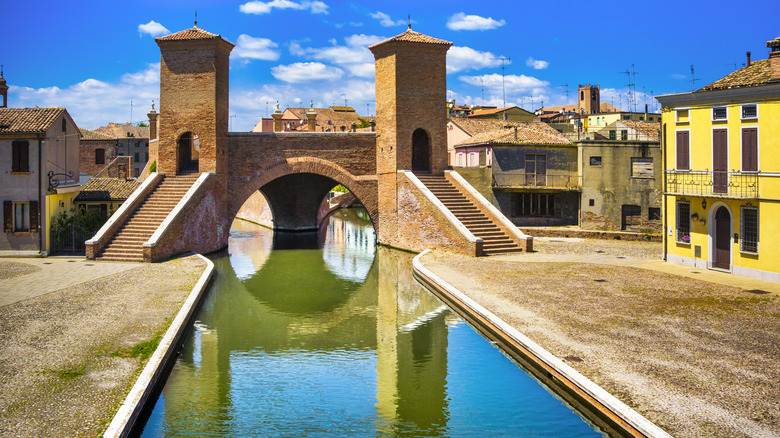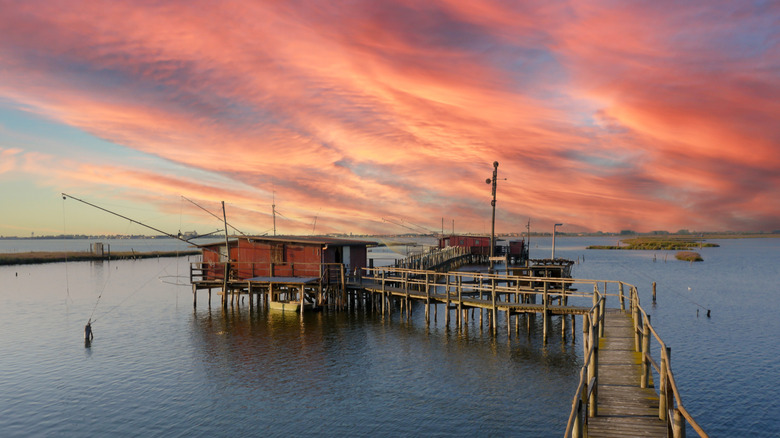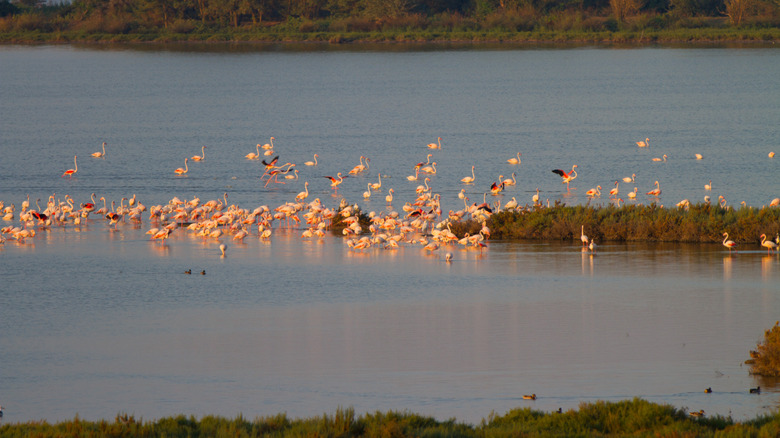Italy's Underrated 'Little Venice' Is A Dazzling Canal Town With Eel Cuisine And Historic Charm
Strolling along a canal hand in hand, street lamps casting a shimmering glow down over you onto the water at night, and winding your way through the town's bridges — all that sounds like a dreamy setting for a Venetian-style romantic escape. Even though we all know there's nowhere else in the world like Venice, Europe still offers a variety of towns with stunning canals. A perfect example is Comacchio, Italy, a picturesque city full of historical monuments and culinary specialties that can charm any type of traveler.
Located around 33 miles from Ferrara, in northern Italy's Emilia-Romagna region, Comacchio is nicknamed "Little Venice" — its canals lined with pastel-painted houses and bridges that criss-cross the historic center evoke the charm of Venice. For over a millennium, Comacchio served as a key trading port on the Adriatic sea. This underrated town is spread over 13 islands; the islands have canals running between them and are connected by 11 bridges. The most famous among them is Ponte dei Trepponti (Bridge of Three Bridges), also known as Ponte Pallotta. This landmark reflects the city's identity and serves as a main portal to the historic district. Built to defend the town of Comacchio and completed in 1638, it's a one-of-a-kind five-way bridge whose arches — connected to an Istrian stone floor — provide access to the city above and the fish market beneath.
If you're looking for a picture-perfect spot, head to Ponte degli Sbirri (Bridge of Police) to enjoy the best view of the city. The historic center is so small that it can be explored on foot — or, for something more unusual, by batana, a traditional boat used to fish in the shallows. Since Comacchio doesn't have its own airport, the best way to reach the town is from Bologna. Renting a car can save you lots of time — the drive takes about an hour and a half, or two hours from Venice.
The traditional eel cuisine of Comacchio
With their snake-like appearance, eels may not be everyone's favorite animal; however, in Comacchio they're considered a local delicacy. This slippery fish has been part of Comacchio's culinary history since the Roman Empire, when fishing played a key role in sustaining the local economy. Thanks to the town's geographical position — where fresh and saltwater converge into the Po river — it remains an ideal habitat for eels.
Historically, since fishing is only allowed between October and December, only some parts of the fish were consumed when recently caught while the rest was stored for later use. This led to the practice of marinating the eels — a tradition believed to have originated in the Middle Ages. After being caught, the eels get decapitated, placed on skewers, and lightly roasted in a large open fire. Once nicely cooked, they are removed from the skewer and left to cool until they reach room temperature. As the last step, the body is diced and marinated with salt, vinegar of Modena, and water: voilá, ready to be stored in a jar. The main eel marination processing center was Manifattura dei Marinati, which adopted a specific method to change the water while keeping the eel alive. Visitors can still tour this historic facility. Besides being marinated, the eels are also grilled or added to a stew.
Eels also have their own local food fair, the Sagra dell'Anguilla, held every year toward the end of September. The 17-day festival revives traditional recipes and includes an exhibition path featuring local products and artworks. During the festival, indulge in gourmet specialties like pasta with seafood sauce, grilled eels with polenta, or eel risotto. We knew it already, but Italy is undoubtedly one of the most mouth-watering food destinations to visit.
History and nature in Comacchio
Comacchio is a town meant to be discovered through its alleys, natural surroundings, and museums. One of the main cultural centers is the Ancient Delta Museum, which tells the story of the region through artifacts from prehistoric times to the Roman Empire period, and is also home to the remains of a merchant ship destroyed in a shipwreck. In the historic center, the Loggia del Grano (Wheat Loggia) and Torre dell'Orologio (Clock Tower) are landmarks of the city. The loggia is a 17th-century building that was once constructed as a public granary for the poor, while the adjacent clock tower was erected in 1842, replacing the original 14th-century monument.
Comacchio is crossed by the Po river and is part of the Po Delta Park — the largest wetland system in Italy — whose lagoons have become its main attraction. The ancient man-made saltpans, created for salt gathering, span 600 hectares and have evolved into a thriving habitat for both birds and plants, making them an ideal stopover for migratory species like pink flamingos, which integrate naturally into the lagoon landscape.
The Valleys of Comacchio are open to the public, making them a perfect spot for cycling, horse riding, and birdwatching. If you want to visit the saltpans, you can book a guided tour to take you through the area. Comacchio is also famous for a lively celebration: the Carnival on the Water. Among the best destinations to celebrate Carnival, Comacchio offers a parade that fills its streets and canals with colorful costumes and figurative boats.


